
Tour of the Fairgrounds
This is Part 12 of our series “Opening Day of the World’s Fair,” which explores the events of May 1, 1893, at the World’s Columbian Exposition in Chicago. The full series can be found here.
After the “Banquet of Nations” luncheon, President Cleveland and his entourage embarked on a whirlwind tour of the Columbian Exposition grounds and buildings. They departed from the north entrance of the Administration Building where carriages were waiting.

“President Cleveland and President Higinbotham Passing the Manufactures and Liberal Arts Building” [Image from Harper’s Weekly, May 13, 1893.]
Procession to the Manufactures and Liberal Arts Building

“Making a Spurt in the Manufactures Building” from the Chicago Inter Ocean April 30, 1893.
When it became known that the president was leaving the Administration Building, crowds of visitors rushed to the spot and almost swept away the 15th Infantry, which was attempting to keep the carriageway clear. “There’s Hoke Smith,” shouted someone in the crowd who recognized the U.S. Secretary of the Interior. The crowd offered a hearty burst of cheer. “Look at Judge Gresham,” yelled another, encouraging more cheers for the popular Chicagoan.
The infantry cleared a path for the president and many in the luncheon party to ride toward the Manufactures and Liberal Arts Building, where commissioners of the various foreign governments were waiting to receive them.
Unfortunately, many fair visitors had anticipated the president’s route. Throngs of people lined the drive, anxious to see the president as he passed. Long before the Mr. Cleveland had pressed the key on stage, it occurred to many in the crowd about the Grand Basin to make a rush for the Manufactures Building. The great exhibition hall was supposed to be closed to the public during the president’s visit, but some 25,000 spectators packed its central Columbian Avenue, just as exhibitors were scrambling to make final preparations for the guest of honor.

Floor map of the Manufactures and Liberal Arts Building [Image from Diagrams of World’s Fair Buildings (Rand McNally, 1893).]
Displays of the nations in Manufactures Hall

“Columbia Avenue, Waiting for President Cleveland” from the Chicago Daily Tribune May 2, 1893.
Cleveland’s party entered the south end of Manufactures Hall at 2 o’clock, where a troop from the 7th U.S. Cavalry kept crowds back and the 15th Regiment band played.
Waiting to greet the President of the United States were distinguished commissioners—many wearing their court uniform—from Germany, Great Britain, France, Italy, Austria, Japan, Russia, Norway, Belgium, Mexico, Persia, Spain, Brazil, Switzerland, New South Wales, and Korea. They were dispatched from the area under the chime tower to their respective exhibit areas in order to make room for the procession to pass.
Colonel Rice of the Columbian Guard, mounted on his horse, galloped up Columbia Avenue to clear a path. As the procession passed through the southern end of the building, the 15th Infantry band played military airs of various nations.
The presidential party made their way down the center aisle of the great hall first to the Russian section. Instead of the czar’s treasures, the only item on display was a sign reading “RUSSIA. EXHIBIT DELAYED ON ACCOUNT OF THE ICE BLOCKADE IN THE BALTIC SEA.”
Next to the Russian section was that of Norway, and on the opposite side of Columbia Avenue were the exhibits from Switzerland and Denmark. Immediately north of Russia were Belgium and Canada displays. On the southeast corner of the grand center was the unfinished French exhibit. When President Cleveland arrived at the British section on the southwest corner, a burst of cheer greeted him.

“Presidential Reception in the Manufactures Building” from the Chicago Inter Ocean May 2, 1893.
On the northwest corner of the center, the imperial German commissioner, Herr von Wermuth, welcomed the president to Germany’s display. A combined German cavalry band and artillery band—neither having a single man under six feet tall—played to the crowd. Then on to the Austria exhibit, which presented a finished and imposing appearance.
North of that was the Japanese building. Facing the grand center on the northeast corner and extending along the central avenue to the limit of the building were the spaces assigned to the United States. The building furnished by Tiffany & Company and Gorham & Co., yet unfinished, stood on the corner.
For more than an hour, the president continued though the hall to visit each foreign display.
One older gentleman with white hair walked alone down Columbian Avenue. Some in the crowd recognized him as one of the historical landmarks in the annals of this country. He was Frederick Douglass.
A more conspicuous figure also moved along the avenue, attended to by an entourage in court attire. This was Ibrahim Hakky Bey, Imperial Commissioner from the realm of the Sultan.

“Director-General Davis Introducing President Cleveland to the Foreign Commissioners in the Manufactures and Liberal Arts Building” [Image from Harper’s Weekly, May 13, 1893.]
Boat ride around the Lagoon

“An electric launch” [Image from Frank Leslie’s Illustrated May 18, 1893.]
Grover Cleveland and his cabinet stepped into one launch, along with Director-General Davis and his commissioners. President Higinbotham expressed some concern about adding his weight to the already full watercraft, but boarded anyway. The president stood up at the stern of the boat to acknowledge the cheers of the growing crowd assembling along the shore, some spectators nearly tumbling in the water in their eagerness to get closer. President Palmer escorted the Duke of Veragua and his party into a second launch.
The launches, travelling at a merry rate, took the party on a tour of the east side of the Lagoon past the Fisheries Building and northward toward the Palace of Fine Arts. As they rode down the west side, President Cleveland admired the beautiful Wooded Island on his left, describing it as “nature undefiled.” Passing the Transportation Building on the right, Secretary Carlisle provided a sarcastic retort, calling Sullivan’s building “art defiled.”
The Secretary of the Navy Hilary A. Herbert was on board the launch, and his Commander in Chief was eager for Herbert to take the helm of the newest type of water craft. Immediately upon taking charge of the boat, Hilary broke a cable and returned the wheel to the captain.

“Presidential Party About to Take the Electric Launch for a Trip on the Lagoon” [Image from Harper’s Weekly, May 13, 1893.]
Mayor Harrison wanders about the grounds

“Arrival of the President at the Agricultural Building” from the Chicago Inter Ocean May 2, 1893.
Meanwhile, Mayor Harrison had been left out of the assignment of places in the presidential and ducal launches and so had stepped into a third boat. Instead of following the presidential party, however, his launch turned to the southern lagoon in expectation that Mr. Cleveland would disembark there. Once Mr. Harrison’s boat docked, he wandered about the grounds for half an hour in a vain search for President Cleveland and members of his cabinet.
After a pleasant journey around the edges of the lagoon, the president’s boat rounded the Statue of the Republic and docked at the steps in front of the Agricultural Building, where a large crowd awaited. Cleopatra when she landed before Alexandria could not have received a more royal welcome.
Carriage tour led by Korean band
It was intended that Mr. Cleveland should tour the Agricultural Building to see the beautiful displays of natural products of every country under the sun. There was not enough time, though.
Instead, the president and his cabinet transferred at once to carriages for a tour of the eastern side of the fairgrounds. They rode eastward along the south shore of the basin to the Peristyle and then north along the drive between the east side of the Manufactures and Liberal Arts Building and the lakeshore.

Britain’s “Victoria House” on the lake shore. [Image from Official Views of the World’s Columbian Exposition (Press Chicago Photo-gravure Co., 1893).]
Americans watched with curiosity as the Duke of Veragua rode by, wondering what traits of his ancestor may be preserved in the lineage over the past 400 years.
By carriage, Mr. Cleveland viewed Britain’s Victoria House, the Spanish and French structures, and other European national buildings along the lakeshore. He stopped to admire one of the most splendid views of the fair: the great inland seas of Lake Michigan. The president pointed with wonder toward the replica of the great battleship Illinois.
Cleveland could not take it all in
Continuing northwest into the section of state buildings, the procession slowed as they passed by the New York State Building and then continued to the north entrance of the Palace of Fine Arts. The President made a bee-line though the central aisle of the art palace before emerging from the southern entrance on the Lagoon. Daniel Burnham worked to herd some stray cabinet members who had drifted off among the sculptures.

The Palace of Fine Arts, [Image from the Rijksmueum, Amsterdam.]
The launches landed near the Electrical Building, and the president was escorted back into the Administration Building at around 4:30. He rested in President Higginbotham’s room on the third floor, chatting with local directors and national commissioners of the Fair while puffing heartily on his cigar. Columbian Guards apparently did not harass the president this time. The wives of Secretaries Morton and Herbert arrived to present Mr. Cleveland with a beautiful bouquet of calceolarias.
“Who might you be?”
Mayor Harrison could not seem to cut a break this day.
Upon arriving at the Administration Building to finally regroup with the presidential party that he had lost, Mr. Harrison asked a Columbian Guard “Which way did President Cleveland go?”
“Up beyant there,” replied the guard.
“Then I want to get up beyant there,” said the Mr. Harrison.
“Who might you be?”
“Carter Harrison,” supplied the mayor, indignant.
“Who’s he?”
“The mayor of Chicago,” thundered Harrison.
“Then ye can’t git in,” concluded the guard.
Colonel Rice arrived in time to clear the matter up and allow the mayor to proceed “beyant there.”
President Cleveland returns to his own Administration Building

Grover Cleveland [Image from The Graphic History of the Fair (Graphic Co., 1894).]
Departing from the north entrance of the Administration Building a few minutes before 5 o’clock, President Cleveland stepped into a carriage pulled by four bright horses. The president was whisked out of the fairgrounds in order to reach Grand Crossing train station, 2 miles southwest of Jackson Park, in time for his 5:10 pm departure back to Washington and his own Administration Building.
To satisfy his wish, a group of Irish women arrived from the Midway to serenade President Cleveland as he departed Chicago.
SOURCES
(See our note about sources here.)
“Around the Grounds” Chicago Daily Tribune May 2, 1893, p. 2.
“Epoch in History” Chicago Herald May 2, 1893, p. 1.
“He is Coming Back” Chicago Inter Ocean May 2, 1893, p. 1.
“He Met Foreigners” Chicago Daily Tribune May 2, 1893, p. 6.
“In the Grand Stand” Chicago Daily Tribune May 2, 1893, p. 1.
“The World’s Columbian Exposition” Harper’s Weekly May 13, 1893, p. 2.

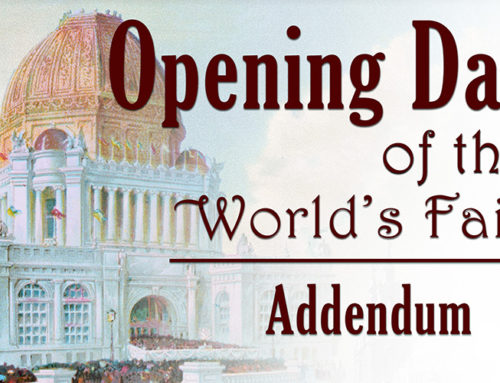
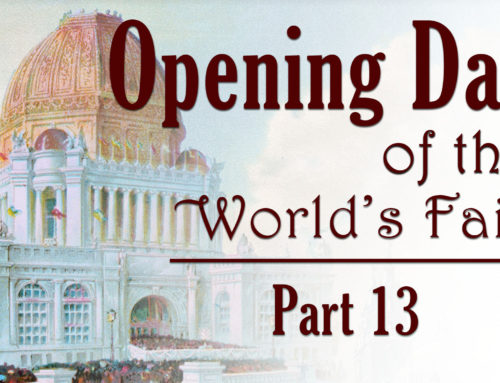
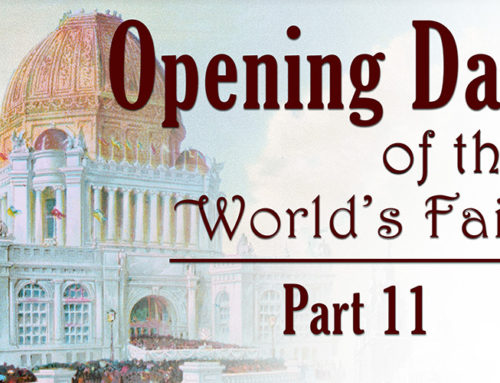
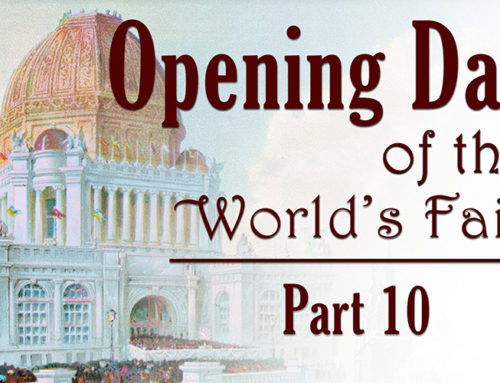
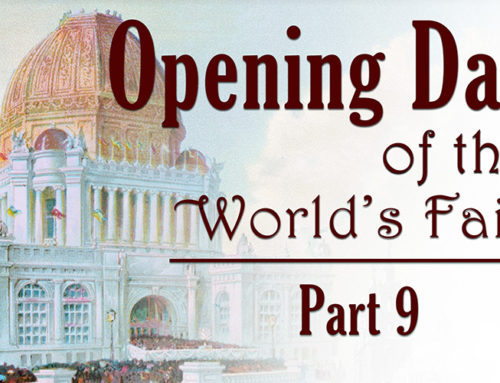
Leave A Comment